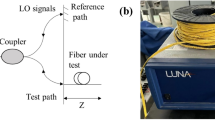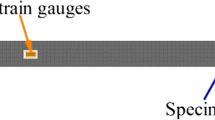Abstract
This paper presents a new method for direct measurement of Mode-I stress intensify factor of cracks using Ba0.64Sr0.36TiO3 flexoelectric strain gradient sensors. Firstly, strain gradient field around the opening mode crack tip was analyzed, followed by the derivation of induced flexoelectric polarization in the strain gradient sensors attached in the vicinity of a crack tip. It was found that the constant stress term makes no contribution to the strain gradient, thus the flexoelectric output directly reflects the singular effect. This unique property eliminates the special requirement for sensor placement coordinates and improves the accuracy of the stress intensify factor predication. A specimen with Mode-I crack was then prepared with two strain gradient sensors (4.7 mm × 0.9 mm × 0.3 mm) attached close to the crack tip to verify the analytical model for measurements of stress intensity factor. The experimental results matched well with the empirical estimation confirming that flexoelectric strain gradient sensing can be a convenient and accurate avenue for measuring the stress intensify factor.





Similar content being viewed by others
References
Boller C (2000) Next generation structural health monitoring and its integration into aircraft design. Int J Syst Sci 31(11):1333–1349
Rybicki EF, Kanninen MF (1977) A finite element calculation of stress intensity factors by a modified crack closure integral. Eng Fract Mech 9(4):931–938
Etheridge J, Dally J (1977) A critical review of methods for determining stress-intensity factors from isochromatic fringes. Exp Mech 17(7):248–254
Hild F, Roux S (2006) Measuring stress intensity factors with a camera: Integrated digital image correlation (I-DIC). Comptes Rendus Mécanique 334(1):8–12
Clark AV, Mignogna RB, Sanford RJ (1983) Acousto-elastic measurement of stress and stress intensity factors around crack tips. Ultrasonics 21(2):57–64
Díaz FA, Patterson EA, Tomlinson RA, Yates JR (2004) Measuring stress intensity factors during fatigue crack growth using thermoelasticity. Fatigue Fract Eng Mater Struct 27(7):571–583
Dally JW, Sanford RJ (1987) Strain-gage methods for measuring the opening-mode stress-intensity factor. Exp Mech 27(4):381–388
Fujimoto Y, Shintaku E, Pirker G, Liu G (2003) Piezoelectric sensor for stress intensity factor measurement of two dimensional cracks. Eng Fract Mech 70(9):1203–1218
Huang W, Yan X, Kwon SR, Zhang S, Yuan FG, Jiang X (2012) Flexoelectric strain gradient detection using Ba0.64Sr0.36TiO3 for sensing. Appl Phys Lett 101(25):252903
Kogan SM (1964) Piezoelectric effect during inhomogeneous deformation and acoustic scattering of carriers in crystals. Sov Phys Solid State 5(10):2069–2070
Tagantsev AK (1986) Piezoelectricity and flexoelectricity in crystalline dielectrics. Phys Rev B 34(8):5883–5889
Tagantsev AK (1991) Electric polarization in crystals and its response to thermal and elastic perturbations. Phase Transit 35(3–4):119–203
Cross LE (2006) Flexoelectric effects: charge separation in insulating solids subjected to elastic strain gradients. J Mater Sci 41(1):53–63
Ma WH, Cross LE (2002) Flexoelectric polarization of barium strontium titanate in the paraelectric state. Appl Phys Lett 81(18):3440–3442
Maranganti R, Sharma P (2009) Atomistic determination of flexoelectric properties of crystalline dielectrics. Phys Rev B 80(5):054109
Huang WB, Kim K, Zhang SJ, Yuan FG, Jiang XN (2011) Scaling effect of flexoelectric (Ba, Sr)TiO3 microcantilevers. Phys Status Solidi-Rapid Res Lett 5(9):350–352
Huang W, Kwon SR, Zhang S, Yuan FG, Jiang X (2013) A trapezoidal flexoelectric accelerometer. J Intel Mat Syst Str. doi:10.1177/1045389X13491021
Shen Z, Chen W (2012) Converse flexoelectric effect in comb electrode piezoelectric microbeam. Phys Lett A 376(19):1661–1663
Qi Y, Kim J, Nguyen TD, Lisko B, Purohit PK, McAlpine MC (2011) Enhanced piezoelectricity and stretchability in energy harvesting devices fabricated from buckled PZT ribbons. Nano Lett 11(3):1331–1336
Anderson TL (2005) Fracture mechanics: fundamentals and applications. CRC press, Boca Raton
Ma WH (2010) Flexoelectric charge separation and size dependent piezoelectricity in dielectric solids. Phys Status Solidi B 247(1):213–218
Zhu WY, Fu JY, Li N, Cross L (2006) Piezoelectric composite based on the enhanced flexoelectric effects. Appl Phys Lett 89(19):192904
Gross D, Seelig T (2011) Fracture mechanics: with an introduction to micromechanics. Springer, Verlag Berlin Heidelberg
Shu L, Wei X, Pang T, Yao X, Wang C (2011) Symmetry of flexoelectric coefficients in crystalline medium. J Appl Phys 110(10):104106
Acknowledgments
This material is based on work supported by, or in part by, the US Army Research Laboratory and the US Army Research Office under contract/grant number W911NF-11-1-0516 and in part by National Science Foundation under grant number CMMI-1068345. We also appreciate De Zhang and Jared Little’s help for the experimental implementation.
Author information
Authors and Affiliations
Corresponding authors
Rights and permissions
About this article
Cite this article
Huang, W., Yang, S., Zhang, N. et al. Direct Measurement of Opening Mode Stress Intensity Factors Using Flexoelectric Strain Gradient Sensors. Exp Mech 55, 313–320 (2015). https://doi.org/10.1007/s11340-014-9914-y
Received:
Accepted:
Published:
Issue Date:
DOI: https://doi.org/10.1007/s11340-014-9914-y




